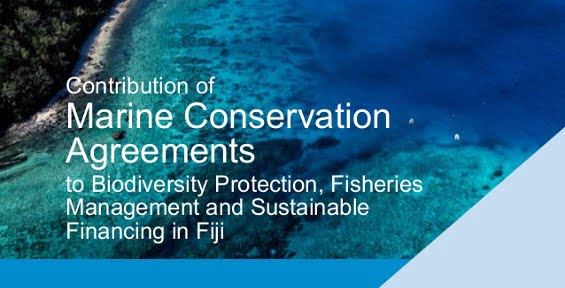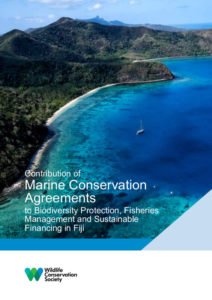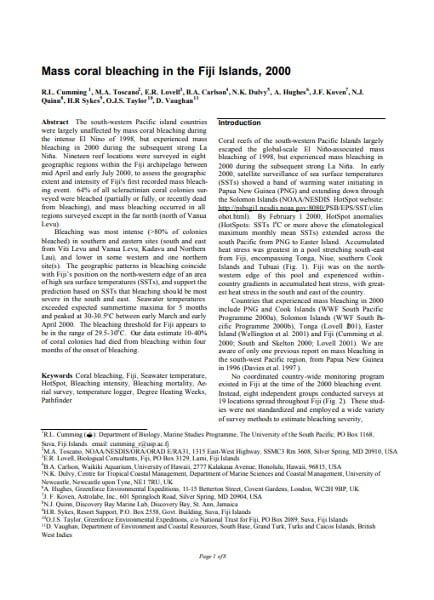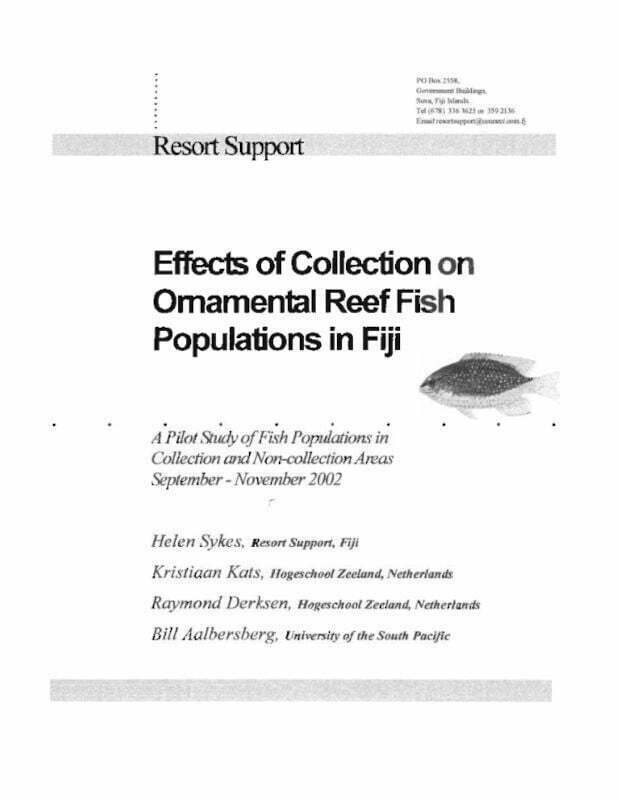Helen Sykes, Marita Manley and Sangeeta Mangubhai have just finished the report on the “Contribution of Marine Conservation Agreements to Biodiversity Protection, Fisheries Management and Sustainable Financing in Fiji.”
WCS-MCA-Fiji-Report-040518-2
The report, published by WCS Fiji, documents the degree and scale to which Marine Conservation Agreements (MCAs) are being used in coastal waters in Fiji. The study focuses on partnerships involving local communities and the tourism sector.The study documented tourism-related MCAs included an estimated 266.25 km2 (26,625 ha) of MPAs, of which 210 km2 (21,000 ha) comprised deep water and offshore reefs within two large no-take reserves (Namena Marine Reserve and Vatu-i-Ra Conservation Park), and the remaining 56.25 km2 (5,625 ha) comprised mostly shallow fringing reefs and slopes.
The report highlights there are many more MPAs out there (especially informal ones), that are probably not being recognised or included in our national reporting.
Download here: WCS MCA Fiji Report 040518 2(3.9MB)

Executive Summary
The marine environment is a vital resource for Fiji’s tourism, yet industry and community efforts to conserve and improve it have largely gone unrecognised, and are under-utilised in Fiji’s tourism marketing. The Wildlife Conservation Society and Marine Ecology Consulting conducted a study between 16 March and 30 October 2017 to document the degree and scale to which Marine Conservation Agreements (MCAs) are being used in coastal waters in Fiji, and what contribution they are making to biodiversity conservation, fisheries management and sustainable financing.
Marine Conservation Agreements are “any formal or informal understanding in which one or more parties commit to delivering explicit economic incentives in exchange for one or more other parties committing to take certain actions, refrain from certain actions, or transfer certain rights and responsibilities, to achieve agreed-upon ocean or coastal conservation goals”. The Nature Conservancy (2010)
The study focuses on partnerships involving local communities with land-sea tenure rights and the tourism sector. It concentrates on the experiences and perceptions of the tourism sector, some of whom are local operators and resource owners. Documenting the motivations and opinions of the community resource owners was outside the scope of this study, and could usefully form the basis of a companion study to better understand their perceptions and commitment to the MCAs, and the direct and indirect benefits they receive.
A total of 115 members of the tourism sector in Fiji, and one non-profit organisation were contacted for this study, and the key findings of the report are summarised below:
- Fiji is known as a leader in community-based marine conservation, but the contribution of MCAs has largely gone unrecognised. Fiji’s social and customary tenure systems provide a unique foundation for the establishment of MCAs between traditional leaders and their communities and the tourism sector.
- A number of tourism operators and communities, and one non-profit organisation have worked on MCAs for many years, all of which include some type of Marine Protected Area (MPA). These agreements contribute to Fiji’s national marine conservation goals, and protect specific areas important to vulnerable megafauna and sensitive ecosystems.
- Most tourism operators in Fiji acknowledge that a pristine marine environment is one of the most important resources in attracting tourists to Fiji, and are willing to spend resources protecting it.
- Of the 81 tourism operators that participated in the survey, 56 (69%) had been involved, were involved, or were becoming involved, in some form of MCA, all of which focused on establishing temporary or permanent no-fishing zones or MPAs. Many of these are long-term investments, some dating from the mid-nineties, with informal agreements originating before that, when the resorts were first built.The Nature Conservancy (2010); www.mcatools.org
- Tourism-related MCAs included an estimated 266.25 km2 (26,625 ha) of MPAs, of which 210 km22 (21,000 ha) comprised deep water and offshore reefs within two large no-take reserves (Namena Marine Reserve and Vatu-i-Ra Conservation Park), and the remaining 56.25 km2 (5,625 ha) comprised mostly shallow fringing reefs and slopes. Other types of MCAs were the two statutory (gazetted) reserves, Shark Reef and Wakaya, which included buffer zones around the MPAs where certain types of fishing gear were not allowed. An additional 400 km2 of reef were within 15 MCAs established by a non-profit organisation Seacology 2 who offered an exchange of benefits for conservation contracts.
- Only 16 (28%) of the tourism-related MCAs included explicit economic incentives to the resource-owning local communities such as some level of payment, provision of infrastructure, or employment opportunities directly related to marine conservation. The remaining 40 (72%) supplied less quantifiable benefits such as sustainable marine resources and/or general employment in the tourism sector. However, the 16 MCAs with explicit economic benefits included the Namena Marine Reserve and Vatu-i-Ra Conservation Park, and encompassed 83% of the total marine environment protected under tourism-related agreements.
- Most of the MCAs relied on verbal and written agreements from local resource-owners, utilising traditional practices such as no-fishing tabu areas over an indefinite period. Others had completely informal courtesy agreements that local people would not fish immediately in front of the resort. Only 9% were supported in law. Around half of the tourism operators were happy with their current agreements, although they would welcome measures to further formalise and map their MPAs. The other half would like to have assistance with more formal protection agreements, or would be content with mapping and recognition from the Ministry of Fisheries in order to legally exclude their MPAs from commercial fishing licences. Only eight operators, with MCAs covering 13.15 km 2 of marine environment, said that they would like to progress to Foreshore Leases or Statutory (gazetted) Reserves.
- Enforcement of MPAs was mostly carried out by resort staff, supported by authorised Fish Wardens, with measures taken against poachers relying much more on traditional authority than on legal action. In many cases tourism operators who had strong familial ties to the local villages reported that they found it difficult to refuse requests for fishing exemptions, while operatives from outside the local community were more willing to enforce the no-fishing rules as long as they had the backing of the traditional authorities. This is based on the views of tourism operators, and further research would be required to validate this perception.
- Where monitoring was conducted, ecological status and guest perceptions were much better documented than socioeconomic impact. Only a small number of operators utilised the information gathered for active management or tourism promotion. Many projects would be improved by greater monitoring and documentation of MCA effectiveness, both ecological and socioeconomic.
- Many tourism operators without MCAs were interested in starting new, or refreshing lapsed agreements, but were unable to find consistent and supportive advice on how to go about this. There is a need for national guidelines to assist both the tourism sector and local communities establish MCAs that create win-win situations for all those involved, while contributing to Fiji’s national and international commitments towards biodiversity protection and sustainable fisheries.
Recommendations
Many members of the tourism sector are already playing a vital role in marine conservation. Promoting the engagement of tourism operators in MCAs can deliver benefits for the tourism industry as a whole, specific operators, local communities and conservation. Key recommendations for policy makers, tourism operators and communities, and partners are provided below.
Policy makers
The government plays a key role in providing the enabling environment to establish, regularise and promote MCAs. Key recommendations for policy makers are:
- Recognise the role and contribution of MCAs nationally to biodiversity protection, fisheries and sustainable financing.
- Provide support to tourism operators and local communities wishing to formalise their agreements, and enforce their MPAs.
- Ensure all commercial fishing licences issued by the Ministry of Fisheries prohibit fishing within MPAs established through MCAs.
- Develop a recognition programme to encourage operators to improve and expand their MCAs. This may include a rating system that acknowledges those with best practice enhancement projects and tangible community benefits.
- Formulate a national tourism marketing plan to raise international awareness of Fiji’s role in leading community and tourism-based marine conservation, and highlighting operators with MCAs.
- Explore opportunities for utilising the Environment and Climate Adaptation Levy (ECAL) revenues to support MCAs involving the tourism sector through partnerships with Ministries of Fisheries, Environment, and of Industry & Trade and Tourism, NGOs and tourism operators. This could include making finance available to, for example, establish and monitor MPAs, offer workshops on environmental conservation for village communities and resort staff, or train and support patrols by Fish Wardens.
- Ensure all MPAs established under MCAs are included in national (e.g. National Biodiversity Strategy Action Plan and Implementation Framework) and international (e.g. Aichi targets under the Convention on Biological Diversity) reporting on conservation targets.
Tourism operators and communities
Where tourism operators and communities are actively engaged in conservation through MCAs, highlighting these efforts could add value to existing marketing strategies. Key recommendations for tourism operators and communities are:
- Ensure the “rules” of the MCAs are acceptable to both the tourism sector and local communities, with clear consequences if those rules are breached.
- Engage the local village community in management and monitoring training and recognition programmes such as environmental awards, local government and community awareness, and media attention.
- Incorporate MCA-related activities into guest programmes, to highlight the role of the tourism sector in conservation.
- Highlight MCAs on websites and in marketing, and engage in regional marketing to showcase conservation efforts in Fiji as a whole. Explore opportunities to apply for international conservation-related awards and certificates.
Partners
There is a need for more standardised information about the establishment, governance and monitoring processes for MCAs to ensure that projects are sustainable into the long term and offer actual benefits. Key recommendations for MCA partners are:
- A “Best Practice” guideline to inform both tourism operators and communities on the available mechanisms for MPA formation, and give examples of MCAs that could be used as models.
- Assist with the formation of a network similar to the Fiji Locally-Managed Marine Area network structure, where tourism operators can share lessons and advice, offer each other support and information, and give or get access to scientific advisors.
- Promote methods for evaluating progress and benefits of MCAs, including both ecological and socioeconomic factors.
Download here: WCS Marine Conservation Agreements Fiji Report (3.9MB pdf)




I may need your help. I’ve been doing research on gate io recently, and I’ve tried a lot of different things. Later, I read your article, and I think your way of writing has given me some innovative ideas, thank you very much.
I have read your article carefully and I agree with you very much. This has provided a great help for my thesis writing, and I will seriously improve it. However, I don’t know much about a certain place. Can you help me? https://www.gate.io/ar/signup/XwNAU
Your point of view caught my eye and was very interesting. Thanks. I have a question for you. https://accounts.binance.com/en/register-person?ref=P9L9FQKY
The point of view of your article has taught me a lot, and I already know how to improve the paper on gate.oi, thank you. https://www.gate.io/ru/signup/XwNAU
I may need your help. I tried many ways but couldn’t solve it, but after reading your article, I think you have a way to help me. I’m looking forward for your reply. Thanks.
Do you mind if I quote a couple of your articles as long asI provide credit and sources back to your website?My blog site is in the very same niche as yours and my users would certainly benefit from some of the information you present here.Please let me know if this okay with you. Thanks!
Can you be more specific about the content of your article? After reading it, I still have some doubts. Hope you can help me. https://accounts.binance.com/ru-UA/register?ref=T7KCZASX